1138 - 1880
Early Redditch depended largely
on the Abbey of Bordesley, a Cistercian Abbey founded
in 1138. From small beginnings of just 12 monks and an abbot,
the site was developed and grew rapidly to include an Abbey Church,
accommodation blocks, farms, stores, outbuildings and other workplaces
associated with the Order.
Bordesley was the only Cistercian House in Worcestershire - others,
such as at Evesham and Great Malvern were of the Benedictine
Order. Great emphasis was placed on manual labour and as it was
usual to have more lay brothers than monks, it was the laity
from the surrounding area who would use the Gatehouse Chapel
of St Stephen for worship. The illustration is from a painting
by J.M. Woodward, a copy of which appeared in R. S. Bartleet's
"The History of Bordesley Abbey" it shows the
interpretation of monastic life at Bordesley Abbey in the 14th
century:
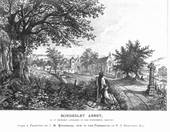 The
Cistercian Order ultimately became very wealthy, as they managed
large farms known as granges, often at some distance from
the Abbey itself, and in this case the home farm was Hewell
Grange at Tardebigge some five miles away. The monks were
also good civil engineers, making use of the River Arrow to create
drainage systems and fish ponds, and harnessing the water power
both for corn mills and for driving trip hammers to forge iron;
however there is no historical evidence for the manufacture of
needles at this date, although the monks may well have made needles
for their own use. Local folklore tells of secret passageways
connecting Bordesley with neighbouring Beoley, but no evidence
of this has been found. The
Cistercian Order ultimately became very wealthy, as they managed
large farms known as granges, often at some distance from
the Abbey itself, and in this case the home farm was Hewell
Grange at Tardebigge some five miles away. The monks were
also good civil engineers, making use of the River Arrow to create
drainage systems and fish ponds, and harnessing the water power
both for corn mills and for driving trip hammers to forge iron;
however there is no historical evidence for the manufacture of
needles at this date, although the monks may well have made needles
for their own use. Local folklore tells of secret passageways
connecting Bordesley with neighbouring Beoley, but no evidence
of this has been found.
At the time of the Dissolution
of the Monasteries in 1538, Bordesley was the fifth wealthiest
Cistercian Abbey in England and Wales. Then, on the orders of
King Henry VIII, the monks were pensioned off and within weeks
of the abandonment of the site the local people were already
looting the stone for their own buildings!
 The Old Chapel of St Stephen at Bordesley,
from "The History of Bordesley Abbey" The Old Chapel of St Stephen at Bordesley,
from "The History of Bordesley Abbey"
The Gatehouse Chapel survived,
though in a poor state. It was used as a cattle shelter at one
time, but in 1687 the parish of Tardebigge applied to the Earl
of Plymouth, now the owner of the land, for permission to reinstate
the chapel as a place of worship, and for use of the old burial
ground. This was an improvement, as the parish church was still
at Tardebigge, not exactly convenient for the populace of the
neighbourhood of Bordesley, many of whom had by now moved about
half a mile up the hill to higher ground, and established a hamlet
around what we now know as Church Green, Redditch.
The description by Joseph Monk (interpreted in the sketch
by Norman Neasom) shows quite a few cottages and houses around
the Green, yet most of the inhabitants would have walked to the
chapel at Bordesley for Sunday Service, or ridden all the way
to Tardebigge (the earliest place of worship in Redditch itself
was the Quaker Meeting House,1704 - 1796). In 1775 the church
tower of the parish church at Tardebigge collapsed and eventually
the elegant new building was built, which is still very much
in use today. (The ruins of Bordesley Abbey have been partly
excavated and detailed reports were written in the 1960s. For
several seasons young archaelogists and their helpers - among
them the author of the web site - spent happy hours in the Bordesley
meadows. Slides of these excavations are to be given to the Museum
at Forge Mill see www.midlandmillsopen.org.uk)
The Chapel on The Green
With the growth of the needle making
industry and consequent increase in population, a chapel was
needed in Redditch itself. By 1805 the dilapidated chapel at
Bordesley, being "in a very decayed and ruinous state
and condition, the roof and ceiling thereof so much decayed that
it has become unsafe for a congregation to attend Divine Worship
there" was finally demolished, and an Act was passed
for the building of a chapel in Redditch itself, on the acre
of Green.
This area was bounded on the south by the public road from Tardebigge
to Ipsley, on the northwest by the road from Headless Cross to
Alvechurch, on the east by the road from Ipsley to Alvechurch
and on the north "by other parts of certain Waste Lands
called The Green". A report from 1839 (later quoted
by The Redditch Indicator) states that The Green was used
for grazing cattle, and that it was a mud patch in winter and
a dust-bowl in summer.
For a description of the first
Chapel on the Green we are indebted to John Noake, who travelled
around Worcestershire in the 1850s, and gave detailed (if very
personal) account of whatever attracted his attention. He reported
that it - "had large semi-circular headed windows with
keystones, pilasters, an apsidal east end, flat celing and, over
the western part of the roof a cupola or miniature dome covered
with some kind of dark metal which gives it an appearance of
a railway engine boiler, surmounted by a gaudy globe and weathercock,
and having a clock face for each of the cardinal points".
He also stated that the chapel was surrounded by a wall, and
a circle of lime trees. (return
to chapter 6)
Although this new St Stephens
chapel (which was dedicated on April 5th 1807), was intended
to accommodate the "considerably increased"
population of over 1,000, the continuing growth in population
had been seriously underestimated, and the chapel had to be enlarged
in 1816/7 and again in 1827.
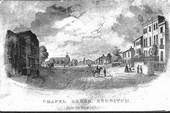 Chapel Green from Fish Hill - the "cupola"
can be clearly seen Chapel Green from Fish Hill - the "cupola"
can be clearly seen
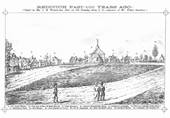 an illustration of Old Redditch, copied
from an old drawing by J.M.Woodward and showing the "architectural
abomination" described by John Noake (above). The houses
are numbered and a key giving the names of the owners is provided an illustration of Old Redditch, copied
from an old drawing by J.M.Woodward and showing the "architectural
abomination" described by John Noake (above). The houses
are numbered and a key giving the names of the owners is provided
St Stephen's Church
1851 - 1880
By 1851 it was decided to demolish
the Chapel on the Green and to build a more substantial parish
church in Gothic style. From that date Chapel Green became
known as Church Green, and the area was further improved
by the planting of more trees. The new church was consecrated
in July 1855. The centenary edition of The Redditch Indicator
recalls the church as it was in 1859, set in a small green and
enclosed by a wall some six feet in height.
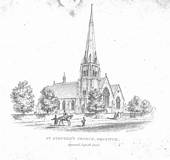 St Stephen's Church in 1855 by W.T.Heming
- the wall can be made out on the enlarged version St Stephen's Church in 1855 by W.T.Heming
- the wall can be made out on the enlarged version
In the 1880s there was a move for
further "improvements" to the appearance of the focal
point of the town. It was decided to remove the wall and replace
with a lower one surmounted by iron railings and at the same
time to enclose the "waste land" known as the
Upper and Lower Greens, Lord Windsor having given up his manorial
rights over his portion of the greens. The enclosure scheme also
included the planting of memorial trees, improvements to kerbing
and pavements, and the provision of the fountain which was to
be erected later by Mr Bartleet. The rate payers were
to contribute to the £1,150 cost of this investment in
civic pride but, as the following poem shows, not everyone was
convinced that the money should come from the rates - the Dissenters
(Non-conformists, of whom there were a considerable number by
this date) thought that the Church of England should pay for
its own wall, and were none too happy about enclosing the green!
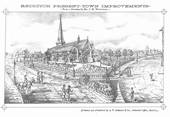 drawing by J.M. Woodward showing "The
Improvements" - the fountain can be seen in the far right
and the premises of Webb & Sons on the extreme right
hand edge drawing by J.M. Woodward showing "The
Improvements" - the fountain can be seen in the far right
and the premises of Webb & Sons on the extreme right
hand edge
THE CHURCH YARD WALL - November 25th 1880 by "Old Redditch"
The Church Wall of St Stephen's
was seedy and old
It looked so deserted and "Out in the Cold",
And how could they manage to muster some Gold
To build a new wall for St Stephen's?
Apply to the Board! It's
a pliable lot,
And try if the funds from the rates can be got:
They probably may not be down to the plot
To get a new wall for St Stephen's
They applied for the wall,
and they put their case well:
The Dissenters, however, had their tale to tell -
They complained in the press and pronounced it a "sell"
On the town for the sake of St Stephen's.
The Church, "they
submitted" should buy its own wall,
There were places beside, do the same for them all;
Than go to the rates rather let the thing fall
What had rates got to do with St Stephen's?
"Never heed",
one winked slily, "T'will come to the same",
And not to be baulked in his 'nice little game';
We must call it 'Improvements' , and alter the name,
We can keep it all right for St Stephen's.
They got out some plans
and propounded a scheme,
And "Church Green Improvements" was topic and theme;
That the wall was the object still none seemed to dream,
The wall that surrounded St Stephen's.
A meeting at once t'was
resolved to convene,
And such unanimity never was seen;
They condemned the church wall and the useless old green,
But nobody mentioned St Stephen's.
An active committee, with
funds rolling in,
Decided most promptly the work to begin:
While the Victor* looked on with a dignified grin
It was all going well for St Stephen's.
They couldn't succeed,
nor get at us at all,
By asking us plainly to build them a wall:
In the name of 'Improvements' they've wall, green and all,
A very good thing for St Stephen's.
The scheme too, on paper,
looked "so very nice",
"Wanted no competition", "They didn't mind price";
And the rustic old green was cut off in a trice,
And enclosed in the yard of St Stephen's.
Shut out by that fencing,
unsightly and tall,
Sufficient to cut off the view from us all;
We could see just as well through that seedy old wall
As the spikes now surrounding St Stephen's.
In place of the Green that
they've put out of sight,
Is a forest of fencing that hides it all quite,
And a waterless fountain that wants putting right,
Like the palings they've put round St Stephen's.
Will the fountain and water
turn out as they wish?
Will the Waterworks Company "Give them the dish"?
Or will their be plenty for Fountain and Fish,
To play in the ground of St Stephen?
Let the bells of St Stephen's
peal out in the blast,
Announcing the old Green a thing of the past,
And playfully tinkle "We've got them at last,
The Green and a Wall for St Stephen's"
* "Victor" was
Victor Milward, the committee chairman
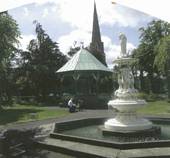 Though amusing, this poem barely masks
the obvious hard feelings of some inhabitants, and it does seem
rather disparaging towards the fountain, which wasn't opened
until May 1883, and which had cost Mr Bartleet £200. The
photo shows the fountain, restored for its centenary in 1983. Though amusing, this poem barely masks
the obvious hard feelings of some inhabitants, and it does seem
rather disparaging towards the fountain, which wasn't opened
until May 1883, and which had cost Mr Bartleet £200. The
photo shows the fountain, restored for its centenary in 1983.
(back
to annex Chapter 6) (back
to Chapter 6)
|